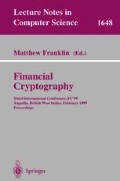Abstract
We introduce two improvements to the recently proposed so called magic ink DSS signatures. A first improvement is that we re- duce the overhead for tracing without noticeably increasing any other cost. The tracing cost is linear in the number of generated signatures in the original proposal; our improved version reduces this to a logarithmic cost in the common case. A second improvement is that we introduce a method for determining whether forged currency is in circulation, with- out affecting the privacy of honest users.
Our improvements rely on our introducing a so called hint value. This is an encryption of the signature transcript received, submitted by the signature receiver. Part of the processing of this hint value is done using a new technique in which the high costs of secret sharing and robust computation on shared data are avoided by manipulation of encrypted data rather than plaintext. (Whereas the idea of computing on encrypted data is not a new notion in itself, it has to the best of our knowledge not previously been employed to limit the use of costly secret sharing based protocols.)
Access this chapter
Tax calculation will be finalised at checkout
Purchases are for personal use only
Preview
Unable to display preview. Download preview PDF.
References
M. Abe, “Universally Verifiable Mix-net with Verification Work Independent of the Number of Mix-servers,” Advances in Cryptology-Proceedings of Eurorypt’ 98, pp. 437–447.
M. Bellare, A. Desai, D. Pointcheval, P. Rogaway, “Relations Among Notions of Security for Public-Key Encryption Schemes,” Advances in Cryptology-Proceedings of Crypto’ 98, pp. 26–45.
S. Brands, “Untraceable Off-line Cash in Wallets with Observers,” Advances in Cryptology-Proceedings of Crypto’ 93, pp. 302–318.
S. Brands, “An Efficient Off-line Electronic Cash Systems Based on the Representation Problem,” C.W.I. Technical Report CS-T9323, The Netherlands.
E. Brickell, P. Gemmell and D. Kravitz, “Trustee-based Tracing Extensions to Anonymous Cash and the Making of Anonymous Change,” Proc. 6th Annual ACM-SIAM Symposium on Discrete Algorithms (SODA), 1995, pp. 457–466.
J. Camenisch, U. Maurer and M. Stadler, “Digital Payment Systems with Passive Anonymity-Revoking Trustees,” Computer Security-ESORICS 96, volume 1146, pp. 33–43.
National Institute for Standards and Technology, “Digital Signature Standard (DSS), ” Federal Register Vol 56(169), Aug 30, 1991.
J. Camenisch, J-M. Piveteau and M. Stadler, “An Efficient Fair Payment System,” Proceedings of the 3rd ACM Conference on Computer and Communications Security, 1996, pp. 88–94.
D. Chaum, A. Fiat and M. Naor, “Untraceable Electronic Cash,” Advances in Cryptology-Proceedings of Crypto’ 88, pp. 319–327.
D. Chaum, “Untraceable electronic mail, return addresses, and digital pseudonyms,” Communications of the ACM, ACM 1981, pp. 84–88.
D. Chaum, “Blind Signatures for Untraceable Payments,” Advances in Cryptology-Proceedings of Crypto’ 82, pp. 199–203.
D. Chaum, H. Van Antwerpen, “Undeniable Signatures,” Advances in Cryptology-Proceedings of Crypto’ 89, pp. 212–216.
D. Chaum, “Achieving Electronic Privacy,” Scientific American, August 1992, pp. 96–101.
D. Chaum and T. Pedersen, “Wallet databases with observers,” Advances in Cryptology-Proceedings of Crypto’ 92, pp. 89–105.
G.I. Davida, Y. Frankel, Y. Tsiounis, and M. Yung, “Anonymity Control in E-Cash Systems,” Financial Cryptography 97, pp. 1–16.
T. ElGamal, “A Public-Key Crytosystem and a Signature Scheme Based on the Discrete Logarithmus,” Advances in Cryptology-Proceedings of Crypto’ 84, pp. 10–18.
N. Ferguson, “Extensions of Single-term Coins,” Advances in Cryptology-Proceedings of Crypto’ 93, pp. 292–301.
Y. Frankel, Y. Tsiounis, and M. Yung, “Indirect Discourse Proofs: Achieving Efficient Fair Off-Line E-Cash,” Advances in Cryptology-Proceedings of Asiacrypt 96, pp. 286–300.
E. Fujisaki, T. Okamoto, “Practical Escrow Cash System”, LNCS 1189, Proceedings of 1996 Cambridge Workshop on Security Protocols, Springer Verlag, pp. 33–48.
R. Gennaro, S. Jarecki, H. Krawczyk, T. Rabin, “Robust Threshold DSS Signatures”, Advances in Cryptology-Proceedings of Eurocrypt’ 96, pp. 354–371.
M. Jakobsson and M. Yung, “Revokable and Versatile Electronic Money,” 3rd ACM Conference on Computer and Communications Security, 1996, pp. 76–87.
M. Jakobsson, “Privacy vs Authenticity,” PhD Thesis, University of California, San Diego,1997.
M. Jakobsson and M. Yung, “Distributed 'Magic Ink’ Signatures,” Advances in Cryptology-Proceedings of Eurocrypt’ 97, pp. 450–464.
M. Jakobsson and M. Yung, “Applying Anti-Trust Policies to Increase Trust in a Versatile E-Money System,” Advances in Cryptology-Proceedings of Financial Cryptography’ 97, pp. 217–238.
M. Jakobsson, “A Practical Mix,” Advances in Cryptology-Proceedings of Eurocrypt’ 98, pp. 448–461.
D. M’Raïhi, “Cost-Effective Payment Schemes with Privacy Regulation,” Advances in Cryptology-Proceedings of Asiacrypt’ 96.
W. Ogata, K. Kurosawa, K. Sako, K. Takatani, “Fault Tolerant Anonymous Channel,” ICISC’ 97, pp. 440–444.
T. Okamoto, “An Efficient Divisible Electronic Cash Scheme,” Advances in Cryptology-Proceedings of Crypto’ 95, pp. 438–451.
R. Ostrovsky and M. Yung, “How to withstand mobile virus attacks,” Proc. of the 10th ACM Symposium on the Principles of Distributed Computing, 1991, pp. 221–242.
T.P. Pedersen, “Distributed Provers with Applications to Undeniable Signatures,” Advances in Cryptology-Proceedings of Eurocrypt’ 91, pp. 221–242.
Birgit Pfitzmann, “Digital Signatures Schemes-General Framework and Fail-Stop Signatures,” LLNC 1100, Springer-Verlag, Berlin 1996
C.P. Schnorr, “Efficient Signature Generation for Smart Cards,” Advances of Cryptology, Proceedings of Crypto’ 98, pp.239–252.
S. von Solms and D. Naccache, “On Blind Signatures and Perfect Crimes,” Computers and Security, 11 (1992) pp. 581–583.
M. Stadler, “Cryptographic Protocols for Revokable Privacy,” PhD Thesis, ETH No. 11651, Swiss Federal Institute of Technology, Zürich, 1996.
M. Stadler, J-M. Piveteau and J. Camenisch, “Fair Blind Signatures,” Advances in Cryptology-Proceedings of Eurocrypt’ 95, pp. 209–219.
Y. Tsiounis, “Efficient Electronic Cash: New Notions and Techniques,” PhD Thesis, College of Computer Science, Northeastern University, 1997. http://www.ccs.neu.edu/home/yiannis
B. Witter, “The Dark Side of Digital Cash,” Legal Times, January 30, 1995.
Author information
Authors and Affiliations
Editor information
Editors and Affiliations
Rights and permissions
Copyright information
© 1999 Springer-Verlag Berlin Heidelberg
About this paper
Cite this paper
Jakobsson, M., Müller, J. (1999). Improved Magic Ink Signatures Using Hints. In: Franklin, M. (eds) Financial Cryptography. FC 1999. Lecture Notes in Computer Science, vol 1648. Springer, Berlin, Heidelberg. https://doi.org/10.1007/3-540-48390-X_19
Download citation
DOI: https://doi.org/10.1007/3-540-48390-X_19
Published:
Publisher Name: Springer, Berlin, Heidelberg
Print ISBN: 978-3-540-66362-1
Online ISBN: 978-3-540-48390-8
eBook Packages: Springer Book Archive

